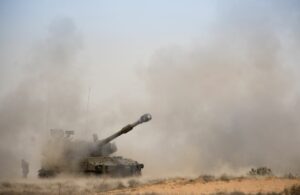Articles
Israel News
January 4, 2024

Israel Shifting to Next Level of Fighting Hamas
Israel began preparations this week for prolonged fighting in the Gaza Strip, reshuffling forces as it weighs how to sustain lower-intensity fighting over the long term. Israel’s top general said that it would take at least several more months to destroy Hamas’s military capabilities, and that fighting could last throughout 2024.
On Monday, the IDF said it would adjust its ground-force composition in Gaza, with plans to rotate five brigades out of the Gaza Strip this week, some of which might be replaced. The military has also recalibrated the types of troops required, now relying more heavily on commando and combat-engineering forces, as Israel increasingly tries to penetrate tunnel infrastructure and hunt down senior Hamas leadership.
“These adaptations are designed to ensure planning and preparation for 2024,” IDF spokesman Daniel Hagari said Sunday night. “The war’s goals require prolonged fighting, and we are preparing accordingly.”
The prospect of an extended period of hostilities in Gaza comes amid friction between Israel and the US, which has been pushing Netanyahu and his government to begin winding down the war.
An unnamed US official told reporters that Israel’s decision to change the composition of its forces in Gaza appears to be in line with a broader shift the Biden administration has been advocating toward- the more discriminate use of force on the part of Israel’s military.
“This appears to be the start of the gradual shift to lower-intensity operations in the north that we have been encouraging, which reflects the success the IDF has had in dismantling Hamas’s military capabilities there,” the official said.
Other Western officials are more cautious, saying that more time was needed to see how the next phase of Israel’s military campaign unfolds. American officials have repeatedly said that it is imperative that Hamas be defeated but that Israeli forces need to show more care to minimize civilian casualties.
While some officials and analysts have questioned whether Israel can succeed in its goal of eradicating Hamas, the new IDF plans reflect the country’s determination to continue to pursue that goal.
Swapping out forces who have been serving for long periods in Gaza is important to refresh weary troops ahead of a planned lengthy campaign. Moreover, demobilizing a portion of the about 360,000 reservists called up for duty since Oct. 7 will ease pressure on Israel’s workforce and its economy.
The war in Gaza has sparked tensions elsewhere in the Middle East and has raised the risk of a broader confrontation between Iran, which has backed Hamas in its goal of destroying Israel, and the U.S., which has moved aircraft carriers and other military support to the area to deter Iran and its allies from attacking Israel.
As noted in the News Mix section, US Navy helicopters over the weekend sank three boats piloted by Houthi fighters, a Yemeni group backed by Iran, after those boats threatened a commercial vessel in the Red Sea. There have been more than 20 Houthi attacks on commercial vessels since November.
The USS Gerald R. Ford carrier strike group will be leaving the region in the coming days, U.S. officials said. A second carrier, the Dwight D. Eisenhower, will continue operating in the Red Sea. Since the start of the war following the heinous October 7 Hamas attack, the U.S. also has deployed additional destroyers and amphibious assault ships throughout the region.
Tasnim, an Iranian semiofficial news agency controlled by the country’s security establishment, said Monday that an Iranian destroyer has been moved to the Red Sea near the Bab el-Mandeb Strait, a key crossing between the Indian Ocean and the Red Sea.
Hamas Deputy Leader Killed
A suspected Israeli attack targeted a Hamas gathering in Beirut on Tuesday, killing at least seven members of the Palestinian terrorist group, including one of its most influential founding members, Saleh al-Arouri; sending shock waves through the Middle East and bringing weekslong hostage negotiations to a halt.
Saleh al-Arouri was a founder of the Hamas military wing, deputy head of its political bureau and, according to the terror group itself, an architect of the group’s October 7 attacks in southern Israel that killed 1,200 people, most of them civilians.
Israel’s leaders have vowed to go after all Hamas leaders around the world involved in the Oct. 7 attacks, and Tuesday’s blast appeared to be the first deadly expansion of its campaign outside the Gaza Strip.
Hamas confirmed Arouri’s death in a statement. The IDF declined to comment on the explosion, and government ministers have been ordered not to discuss it publicly.
Israel’s Army Radio attributed the strike to Israel, and Danny Danon, who served as the country’s ambassador to the United Nations, praised the IDF and the Mossad spy agency for carrying out the attack.
“Anyone involved in the [Oct. 7] massacre should know that we will reach them and get even,” Danon wrote on X.
The assassination has had immediate implications on Israel’s efforts to secure the release of more than 100 hostages abducted during the Simchas Torah attacks and still being held by Hamas. The terrorist group immediately put an indefinite hold on talks in Cairo, according to Egyptian officials.
Israeli military officials said they were bracing for retaliatory strikes from Hezbollah and Hamas terrorists in Lebanon, which has been the source of near-daily cross-border strikes since early October.
After the explosion, Hezbollah called the strike a “serious attack on Lebanon, its people, security, sovereignty, [and] resistance” that would trigger a severe response. “We, in Hezbollah, affirm that this crime will never pass without a response and punishment. This momentous day has consequences.”